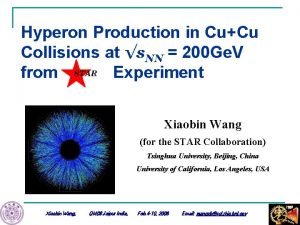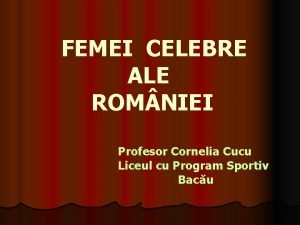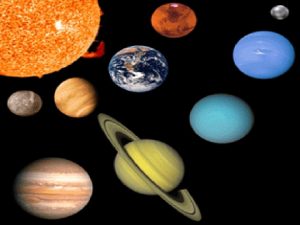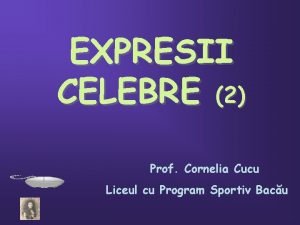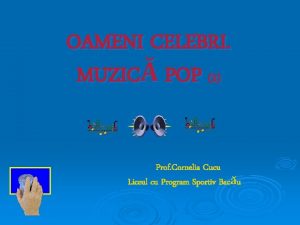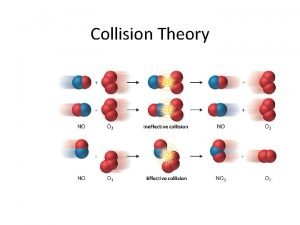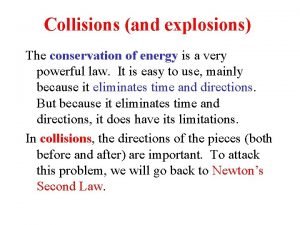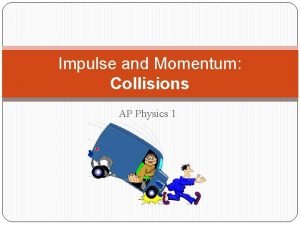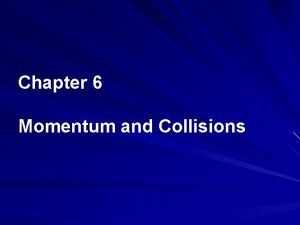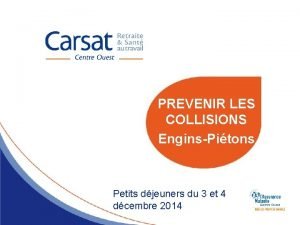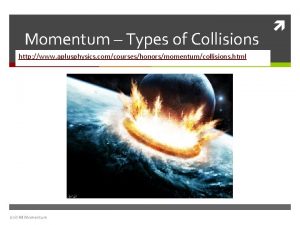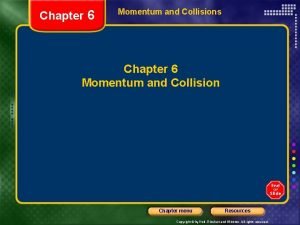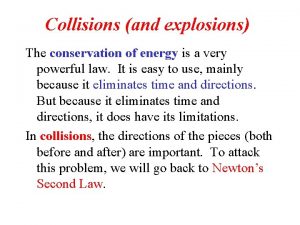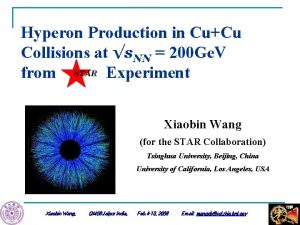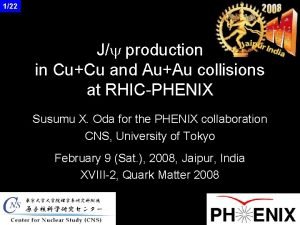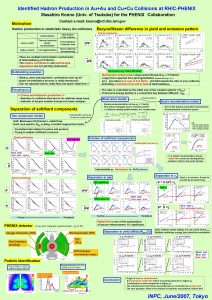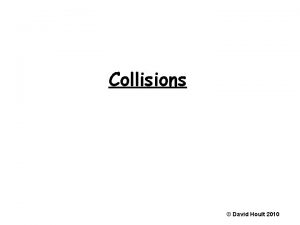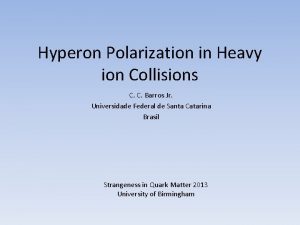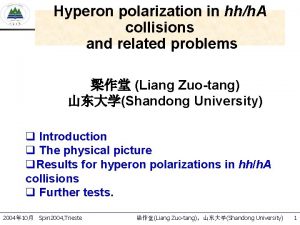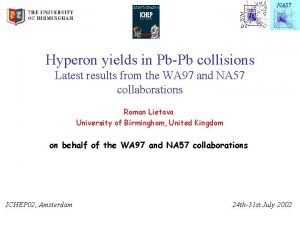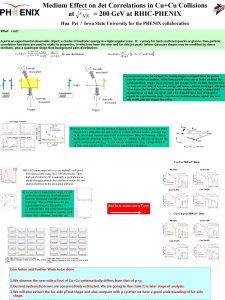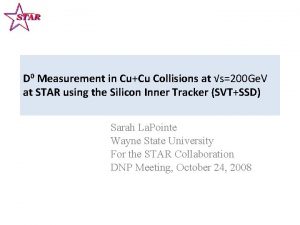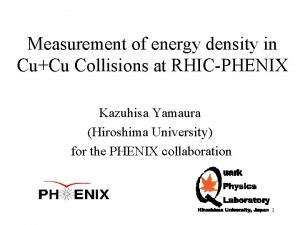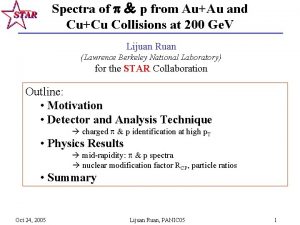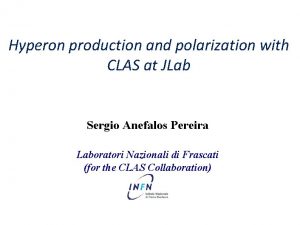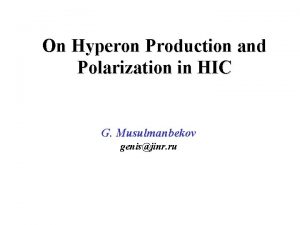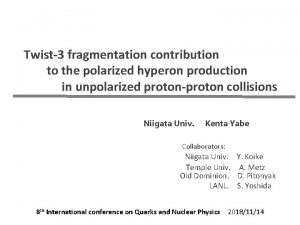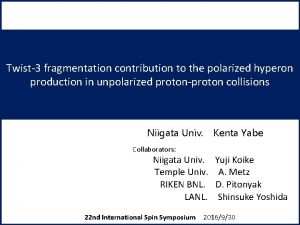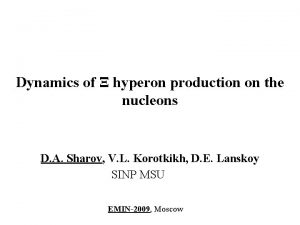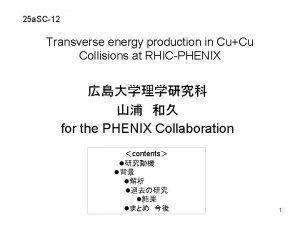Hyperon Production in CuCu Collisions at s NN
















![Page 17 ar. Xiv [Nucl-ex]: 0705. 2511 Xiaobin Wang, QM 08 Jaipur India, Feb. Page 17 ar. Xiv [Nucl-ex]: 0705. 2511 Xiaobin Wang, QM 08 Jaipur India, Feb.](https://slidetodoc.com/presentation_image/5c8d42196d691517065a074b01ed1d2e/image-17.jpg)


- Slides: 19

Hyperon Production in Cu+Cu Collisions at √s. NN = 200 Ge. V from Experiment Xiaobin Wang (for the STAR Collaboration) Tsinghua University, Beijing, China University of California, Los Angeles, USA Xiaobin Wang, QM 08 Jaipur India, Feb. 4 -10, 2008 Email: wangxb@rcf. rhic. bnl. gov

Page 1 Outline Ø Motivation Ø Results of Multi-strange Hyperon Production ü Transverse Momentum Spectra ü Strange Hyperon Ratios ü Yield, Compared with Au+Au and p+p ü Nuclear Modification Factor -- Rcp ü Ω/φ Ratio Ø Summary Xiaobin Wang, QM 08 Jaipur India, Feb. 4 -10, 2008 Email: wangxb@rcf. rhic. bnl. gov

Ø Thermalization and chemical equilibration depends on colliding system – Cu+Cu Au+Au variations ØCanonical suppression increases with increasing strangeness ØCu+Cu system with intermediate Npart numbers is sensitive to strangeness enhancement and its physics implication Au+Au@200 Ge. V STAR Phys. Rev. Lett. 98, 062301 (2007) Xiaobin Wang, QM 08 Jaipur India, Feb. 4 -10, 2008 Email: wangxb@rcf. rhic. bnl. gov Page 2

Ø Rcp scaling consistent with constituent quark degree. Page 3 Au+Au@200 Ge. V STAR Phys. Rev. Lett. 98, 062301 (2007) l Baryon production follows approximately binary scaling at intermediate p. T l Particle formation may involve dynamics of quark coalescence and surface emission (v 2, see poster 204, by D. Gangadharan) l From Au+Au Cu+Cu --- investigating dependence of these features on parton densities and Npart geometry Xiaobin Wang, QM 08 Jaipur India, Feb. 4 -10, 2008 Email: wangxb@rcf. rhic. bnl. gov

Page 4 Ø Ω/φ Ratio from Au+Au@200 Ge. V, most central 0 -12% Hwa&Yang p Ω/φ ratio p. T spectra Phys. Rev. C 75, (Phys. Rev. Lett. 99, 112301 (2007). ) p At mid to high p. T range, thermal plus power-law component p Coalescence Model predicts that for p. T<4 Ge. V/c Ω/φ yields dominated by thermal s quarks. What do Cu+Cu data indicate? Xiaobin Wang, QM 08 Jaipur India, 054904 (2007) STAR Data Phys. Rev. Lett. 99, 112301 (2007) Feb. 4 -10, 2008 Email: wangxb@rcf. rhic. bnl. gov

Page 5 Ø Collision system size, Cu+Cu (Year 2005 data) compares with p+p and Au+Au published results with the same beam energy u Number of nucleons: 63 (Cu) VS: 197 (Au) u Detected charged particle multiplicities define collision centralities u Glauber Model is applied to calculate equivalent number of nucleons that participate in reaction (Npart) and number of binary collisions (Nbin) Xiaobin Wang, QM 08 Jaipur India, Feb. 4 -10, 2008 Email: wangxb@rcf. rhic. bnl. gov

Detectors and Data Set Page 6 Ø ~32. 3 M minbias events analyzed Ø PID by d. E/dx, p /π/ K Ø Hyperon reconstructed through weak decay topology ry ry a n i m A ST Xiaobin Wang, R li e r p QM 08 Jaipur India, li e r Rp na i m A ST Feb. 4 -10, 2008 Email: wangxb@rcf. rhic. bnl. gov

li e r Rp ry a n mi A ST n Λ(anti-Λ) corrected for weak decay feed-downs from other hyperons n p. T distribution fitted by Boltzmann function n power-law component appears significant in peripheral collisions Xiaobin Wang, QM 08 Jaipur India, Feb. 4 -10, 2008 Email: wangxb@rcf. rhic. bnl. gov Page 7

Strange Hyperon Yield Ratio in Most Central Collisions l Most central: Ω(bar)/Ω = 1. 07± 0. 14 Ξ(bar)/Ξ = 0. 80± 0. 06 Λ(bar)/Λ = 0. 83± 0. 03 l Ratios of antihyperon to hyperon p. T independent l W/X = X/L, the ratios may be related to s/d(u) ratios within coalescence framework l See poster 158 & ry ar. Xiv: 0801. 2265 [nuclth] R A ST Xiaobin Wang, lim e r p QM 08 Jaipur India, ina Feb. 4 -10, 2008 Email: wangxb@rcf. rhic. bnl. gov Page 8

Strange Hyperon Yield in Cu+Cu@200 Ge. V Page 9 u Hyperon yields per participant are strongly enhanced in central collisions ina ry m R A ST Xiaobin Wang, li e r p QM 08 Jaipur India, Feb. 4 -10, 2008 u Hyperon yield per participant in Cu+Cu is slightly higher than that in Au+Au at the same number of participant Email: wangxb@rcf. rhic. bnl. gov

Page 10 Strange Hyperon Rcp VS: p. T Distribution Ø Stat. error only Ø Hyperon production follows approximately binary scaling at intermediate p. T Ø Constituent quark number scaling ina ØThese features are consistent with what observed previously in Au+Au at intermediate p. T ry m R A ST Xiaobin Wang, li e r p QM 08 Jaipur India, Feb. 4 -10, 2008 Email: wangxb@rcf. rhic. bnl. gov

Page 11 Ω/φ Ratio in Cu+Cu & Au+Au ry na mi p Cu+Cu@200 Ge. V data stat. error only R A ST p Same trend as Au+Au measurement p Coalescence model by Hwa and Yang can describe the data p. T<4 Ge. V/c Au+Au@200 Ge. V Cu+Cu@200 Ge. V p The model assumes that most of Ω and φ are formed from bulk s quarks. p φ production see J. H. Chen’s talk, v 2 see Y. Lu’s talk for STAR experiment Xiaobin Wang, QM 08 Jaipur India, li e r p Feb. 4 -10, 2008 Email: wangxb@rcf. rhic. bnl. gov

Summary Page 12 Ø Strange hyperon production has been measured from Cu+Cu collisions at RHIC ØW/X = X/L within measured p. T(<4 Ge. V/c) range, may reflect the s/d(u) ratios at hadronization ØFor collisions with the same number of participants, strange hyperon production per participant in Cu+Cu is slightly higher than that in Au+Au at the same energy Ø Strange hyperon yields approximately follow binary scaling at intermediate p. T region(1. 5 -4. 0 Ge. V/c). The Λ and Ξ Rcp values are consistent with the constituent quark number scaling previously observed. Ø Ω/φ ratio for p. T<4 Ge. V/c consistent with coalescence model where Ω and φ are formed mostly from bulk s quarks Thanks! Xiaobin Wang, QM 08 Jaipur India, Feb. 4 -10, 2008 Email: wangxb@rcf. rhic. bnl. gov

Page 14 Back up Xiaobin Wang, QM 08 Jaipur India, Feb. 4 -10, 2008 Email: wangxb@rcf. rhic. bnl. gov

Page 15 Ø Thermalization and chemical equlibration are sensitive to formation of bulk partonic matter Ø Heavy ion collision system dynamics can be: • Chiral symmetry restored, s quark can be produced via • Hadronic system production, requires much higher energy Ø Energy dependence of strange baryon yields has been measured at RHIC and SPS Ø STAR Au+Au result shows Rcp of strange hyperon is affected by number of constituent quarks but not a mass effect Xiaobin Wang, QM 08 Jaipur India, Feb. 4 -10, 2008 Email: wangxb@rcf. rhic. bnl. gov

Strangeness is ‘enhanced’ at SPS Baryon and anti-baryons are both enhanced, but by different amount ! WA 97/NA 57 and NA 49 Consistent Results Yield N-wound No of Wounded Nucleons Xiaobin Wang, QM 08 Jaipur India, Feb. 4 -10, 2008 Email: wangxb@rcf. rhic. bnl. gov
![Page 17 ar Xiv Nuclex 0705 2511 Xiaobin Wang QM 08 Jaipur India Feb Page 17 ar. Xiv [Nucl-ex]: 0705. 2511 Xiaobin Wang, QM 08 Jaipur India, Feb.](https://slidetodoc.com/presentation_image/5c8d42196d691517065a074b01ed1d2e/image-17.jpg)
Page 17 ar. Xiv [Nucl-ex]: 0705. 2511 Xiaobin Wang, QM 08 Jaipur India, Feb. 4 -10, 2008 Email: wangxb@rcf. rhic. bnl. gov

Page 18 Phys. Rev. Lett. 99, 112301 (2007). Xiaobin Wang, QM 08 Jaipur India, Feb. 4 -10, 2008 Email: wangxb@rcf. rhic. bnl. gov

Cent. 0~10% 10~20% 20~30% 30~40% 40~60% <N_ part> 99. 00 74. 55 53. 67 37. 75 21. 54 <N_ bin> 188. 8 123. 6 77. 64 47. 66 22. 72 Λ 4. 82 +/-0. 11 3. 27 +/-0. 09 2. 13 +/-0. 07 1. 39 +/-0. 05 0. 72 +/-0. 03 Λbar 4. 00 +/-0. 10 2. 60 +/-0. 07 1. 83 +/-0. 06 1. 18 +/-0. 04 0. 62 +/-0. 02 Ξ 0. 55 +/-0. 02 0. 38 +/-0. 02 0. 24 +/-0. 01 0. 13 +/-0. 01 0. 072+/-0. 004 Ξbar 0. 44 +/-0. 02 0. 35 +/-0. 02 0. 22 +/-0. 01 0. 14 +/-0. 01 0. 065+/-0. 005 Ω 0. 073+/-0. 010 0. 047+/-0. 008 0. 030+/-0. 006 0. 018+/-0. 004 0. 0077+/-0. 0013 Ωbar 0. 078+/-0. 010 0. 046+/-0. 007 0. 032+/-0. 006 0. 016+/-0. 004 0. 0060+/-0. 0010 Xiaobin Wang, QM 08 Jaipur India, Feb. 4 -10, 2008 Email: wangxb@rcf. rhic. bnl. gov
 Pre production post production
Pre production post production Cucu faimosi
Cucu faimosi Cucu faimosi
Cucu faimosi Cucu de la faimoși
Cucu de la faimoși Faimosul cucu
Faimosul cucu Cucu faimosi
Cucu faimosi Non pluribus impar
Non pluribus impar Cucu faimosi
Cucu faimosi Collision theory easy definition
Collision theory easy definition Elastic collision vs inelastic
Elastic collision vs inelastic To avoid collisions a defensive driver should
To avoid collisions a defensive driver should Collisions and explosions
Collisions and explosions Momentum
Momentum Empty space between traffic clusters
Empty space between traffic clusters A small marble collides with a billiard ball
A small marble collides with a billiard ball Prévention des collisions engins-piétons
Prévention des collisions engins-piétons Aplusphysics momentum-impulse answer key
Aplusphysics momentum-impulse answer key Chapter 6 momentum
Chapter 6 momentum Collisions and explosions
Collisions and explosions To avoid collisions a defensive driver should
To avoid collisions a defensive driver should


